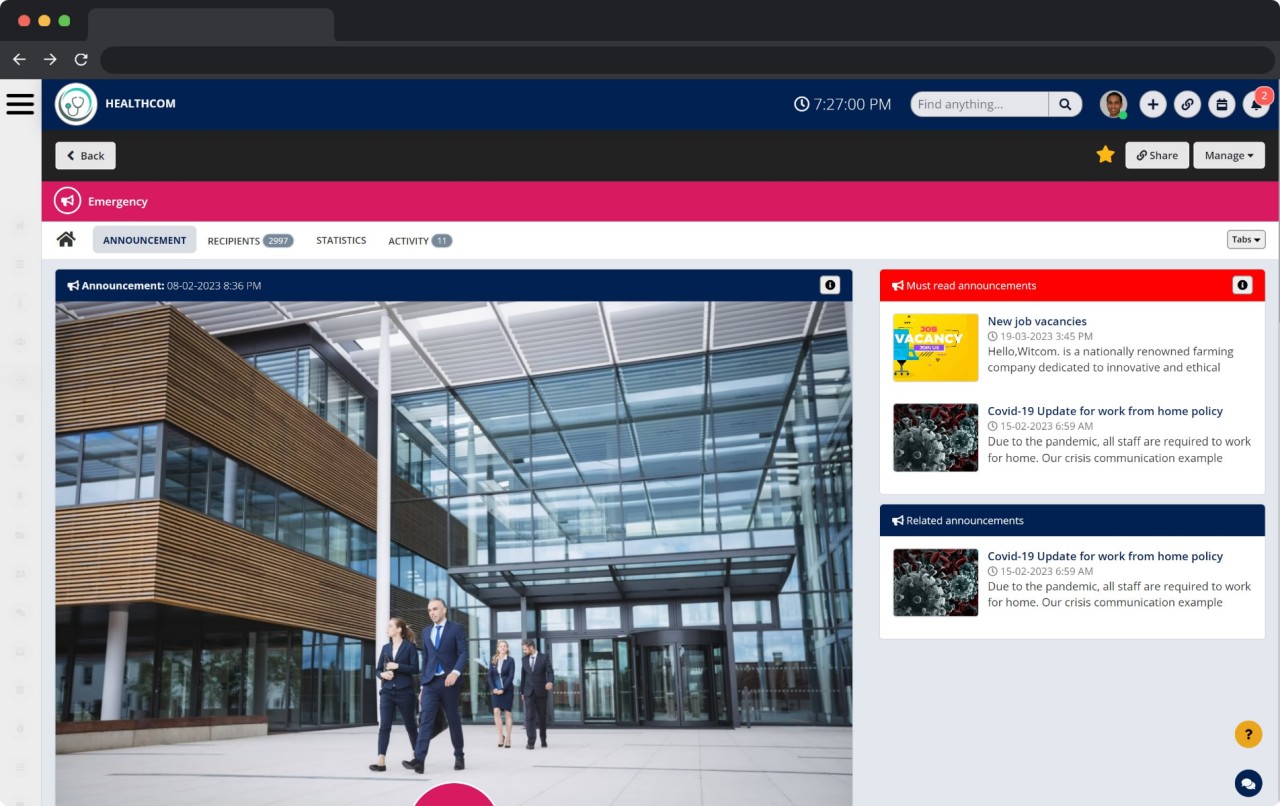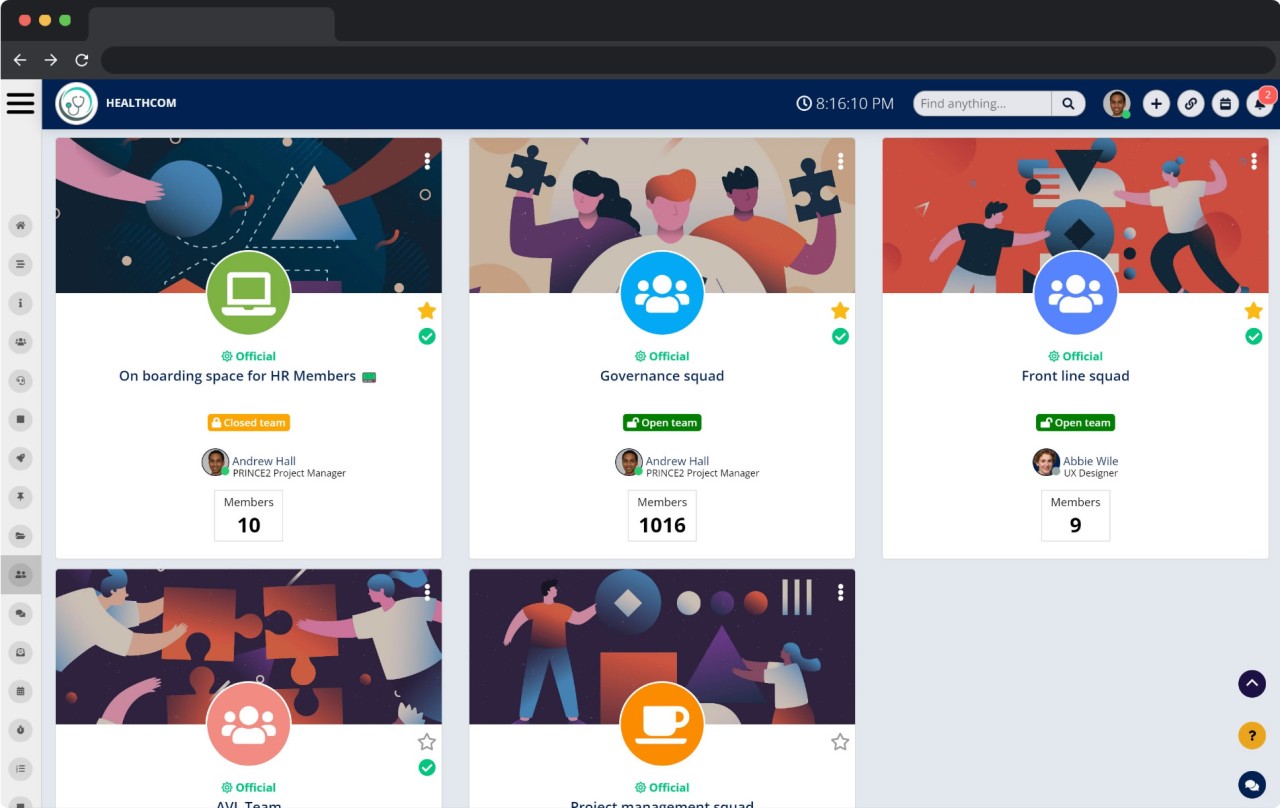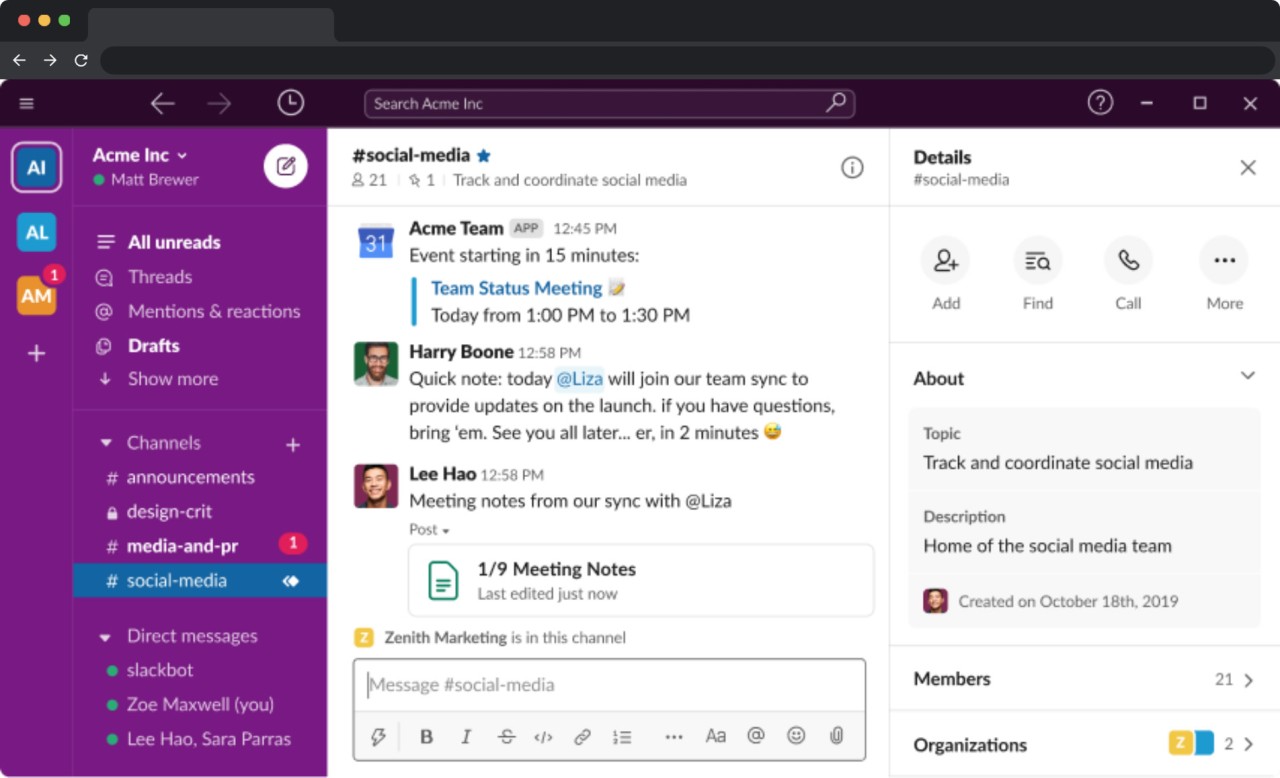Insight Blog
Agility’s perspectives on transforming the employee's experience throughout remote transformation using connected enterprise tools.
23 minutes reading time
(4523 words)
The Importance of Internal Communication For Employee Productivity
Discover how to improve productivity with the best internal communication software, learn the critical factors to consider, and explore top solutions.
In today's fast-paced business environment, effective internal communication is more crucial than ever before.
As organizations become increasingly diverse and geographically dispersed, maintaining clear and efficient communication channels is vital to ensure employees stay engaged, informed, and aligned with company goals.
That's where internal communication software comes in!
In this comprehensive guide, we will delve into why it's essential to invest in internal communication software and our top 5 picks for the most impactful solutions available in the market.
So, without further ado, let's dive in and explore the world of internal communication software and how it can transform the way your organization operates!
Key Takeaways
- Effective internal communication software boosts productivity and employee engagement.
- Consider ease of use, integration capabilities, and security when choosing a platform.
- Top solutions include AgilityPortal, Slack, Microsoft Teams, Workplace by Facebook, and Asana.
- Successful implementation involves clear guidelines, employee adoption, and regular updates.
What is Internal Communication Software?
Internal communication software is a digital solution designed to facilitate effective internal communication within an organization.
These tools enable employees to efficiently share information, collaborate on projects, and engage in real-time conversations. Ultimately, it enhances productivity and fosters a positive work environment.
Choosing the best internal communication software is essential to ensure that your organization's internal communications strategy aligns with its unique needs and goals.
Why Invest in Internal Communication Software?
Improved Collaboration and Efficiency
Investing in internal communication software can lead to significant improvements in collaboration and efficiency within an organization.
By providing a centralized platform for communication, these tools enable team members to engage in real-time interactions, group discussions, and file sharing seamlessly.
This streamlined communication process helps to reduce misunderstandings and miscommunications, enabling teams to work more cohesively and accomplish tasks more quickly.
Furthermore, the right internal communications software can integrate with other internal processes and tools, thereby enhancing efficiency and collaboration even further.
Effective internal communication tools are essential for optimizing collaboration and efficiency in the workplace.
- By adopting the best internal communication software, organizations can experience the following benefits:
- Facilitated real-time interactions and communication among team members
- Reduced misunderstandings and miscommunications, leading to more cohesive teamwork
- Integration with other internal processes and tools, enhancing overall efficiency and collaboration
Increased Employee Engagement
Another advantage of using internal communication software is the positive impact it has on employee engagement.
Effective internal communications help keep employees informed about company news, updates, and goals, ensuring that they feel involved and invested in the organization.
By using internal communications tools, employees can easily access relevant information, participate in discussions, and contribute their ideas and opinions.
This sense of inclusion and involvement promotes a more engaged workforce, which in turn leads to increased job satisfaction, employee retention, and overall productivity.
Investing in the right internal communications software can yield numerous benefits, including:
- Keeping employees informed about company news, updates, and goals
- Encouraging participation in discussions, idea sharing, and feedback
- Creating a sense of inclusion and involvement, resulting in increased job satisfaction and employee retention
Streamlined Information Sharing and Decision Making
Internal communication tools can also streamline information sharing and decision-making within an organization.
By providing a centralized hub for communication, these tools facilitate the rapid dissemination of important announcements, updates, and decisions across the company.
This allows employees to stay up-to-date with the latest developments and ensures that everyone is on the same page.
Additionally, internal communication tools often include features such as polls, surveys, and feedback channels, making it easier for management to gather input from employees and make informed decisions based on collective insights.
Adopting an internal communications software filter can significantly improve information flow and decision-making processes in your organization.
It can provide the following benefits:
- Rapid dissemination of important announcements, updates, and decisions across the company
- Ensuring employees stay up-to-date with the latest developments
- Gathering input and making informed decisions based on collective insights through features like polls, surveys, and feedback channels
Crisis Management and Change Management
In times of crisis or significant organizational changes, clear and timely internal communication is crucial for maintaining employee trust and minimizing disruptions.
During these challenging periods, organizations must be able to react quickly, adapt to new circumstances, and ensure that employees understand the necessary steps and actions.
Internal communications tools and platforms play a vital role in facilitating this process, enabling organizations to share essential updates and instructions, address concerns, and maintain open lines of communication with their workforce.
Effective crisis and change management communication can lead to several benefits, including:
- Rapid dissemination of critical information
- Maintaining employee trust
- Reducing confusion and misinformation
- Facilitating collaboration and problem-solving
- Minimizing disruptions
Enhanced Company Culture
Lastly, internal communications platforms play a pivotal role in nurturing a positive company culture.
By creating a platform for open dialogue, these tools foster an environment where employees feel valued and comfortable expressing their thoughts and ideas.
This transparent communication helps build trust and camaraderie among team members, ultimately resulting in a stronger, more unified organization.
Investing in the best internal communication software can have a profound impact on your company culture.
By fostering a positive environment and promoting transparency, these tools can lead to:
- Employees feeling valued and comfortable expressing their thoughts and ideas
- Building trust and camaraderie among team members
- A stronger, more unified organization through transparent communication
By carefully considering the unique needs and goals of your company, you can find the best internal communications tools to support and enhance your internal communications strategy.
Factors to Consider When Choosing the Best Internal Communication Platforms
1. Ease of Use
One of the most crucial factors to consider when choosing the best internal communication platform is the ease of use.
A user-friendly interface ensures that employees can quickly adapt to the new software, reducing the learning curve and maximizing productivity.
When evaluating potential platforms, consider the following aspects:
- Intuitive design: The platform should be easy to navigate, with a layout that makes it simple for users to find and access various communication channels and features.
- Onboarding process: An effective onboarding process should provide training and support to help employees quickly familiarize themselves with the platform.
- Mobile compatibility: Ensure that the platform offers a mobile app or mobile-optimized interface, allowing employees to access communication tools from anywhere, anytime.
Key Points to Consider for Ease of Use
- Intuitive design and user-friendly interface
- Effective onboarding process and support
- Mobile compatibility for on-the-go access
2. Integration Capabilities
Integration capabilities are another essential factor to consider when selecting an internal communication platform. A platform that seamlessly integrates with your existing tools and processes can significantly enhance collaboration and efficiency.
Look for a platform that offers:
- Integration with popular productivity tools such as project management software, file-sharing services, and CRM systems.
- Support for custom integrations via APIs, allowing you to connect the platform with other tools specific to your organization.
- Single sign-on (SSO) capability to simplify access management and improve security.
Key Points to Consider for Integration Capabilities
- Compatibility with popular productivity tools
- Support for custom integrations via APIs
- Single sign-on capability for streamlined access management
3. Security and Privacy
Security and privacy should be top priorities when selecting an internal communication platform. Your chosen platform should offer robust security features to protect your organization's sensitive data and maintain employee privacy.
Key security and privacy features to look for include:
- Data encryption both in transit and at rest
- Regular security audits and updates
- Compliance with industry-specific regulations, such as GDPR and HIPAA
- Access controls and permissions to ensure that only authorized users can access specific information
Key Points to Consider for Security and Privacy
- Data encryption
- Regular security audits and updates
- Compliance with industry-specific regulations
- Access controls and permissions
4. Scalability
Scalability is another important factor to consider when selecting an internal communication platform. As your organization grows and evolves, your communication needs may change. Ensure that the platform you choose can accommodate your organization's growth and adapt to future requirements.
Key scalability considerations include:
- The ability to add or remove users easily
- Flexible pricing plans that accommodate varying team sizes and budgets
- Support for additional features or customizations as your organization's communication needs evolve
Key Points to Consider for Scalability
- Easy user management
- Flexible pricing plans
- Support for additional features and customizations
5. Customization Options
Customization options allow you to tailor the internal communication platform to your organization's specific needs, ensuring a more personalized and efficient experience for users.
When evaluating potential platforms, consider the following customization options:
- Branding and theming options to align the platform with your organization's visual identity
- Customizable communication channels to accommodate your team's unique workflow and preferences
- The ability to create custom integrations and features to meet specific communication requirements
Key Points to Consider for Customization Options
- Branding and theming options
- Customizable communication channels
- Support for custom integrations and features
Top 5 Internal Communications Software
#1. Our Internal Communication Tool of Choice: AgilityPortal
AgilityPortal is a comprehensive internal communications software that helps organizations streamline communication, collaboration, and knowledge management processes.
This versatile platform is designed to cater to the unique needs of modern businesses, fostering effective internal communication and promoting a more connected workforce.
AgilityPortal connects employees through a centralized hub, enabling them to communicate and collaborate in real-time, regardless of their location.
Key Features of AgilityPortal
AgilityPortal offers a wide range of internal communication tools and features that help organizations drive employee engagement, improve collaboration, and boost productivity.
These key features include:
- Centralized communication hub: AgilityPortal serves as a one-stop platform for all internal communications, making it easy for employees to access relevant information, resources, and communication channels.
- Instant messaging and group chat: Real-time messaging allows employees to communicate instantly, fostering collaboration and promoting efficient problem-solving.
- Video and audio conferencing: The platform supports high-quality video and audio conferencing, making it easy for teams to hold meetings and discussions, regardless of their physical location.
- File sharing and document management: AgilityPortal facilitates seamless file sharing and document management, ensuring that employees have access to the information they need to perform their tasks effectively.
- Task management and team collaboration: The platform's task management feature helps teams stay organized, track progress, and collaborate on projects.
- Employee engagement tools: AgilityPortal offers various employee engagement tools, such as surveys and polls, to help organizations gauge employee sentiment and identify areas for improvement.
Advantages of Using AgilityPortal as an Employee Communication Platform
AgilityPortal's internal communications software provides numerous benefits for organizations looking to improve their internal communication processes:
- Streamlined Communication - The centralized hub ensures that all employees have access to the same information, minimizing the risk of miscommunication and promoting a more cohesive work environment.
- Improved Collaboratio - The platform's robust messaging and conferencing features make it easy for employees to work together on projects and share ideas.
- Increased Employee Engagement - AgilityPortal's employee engagement tools enable organizations to better understand their workforce's needs and concerns, leading to more targeted improvements and a more engaged workforce.
- Simplified Knowledge Management - AgilityPortal's file sharing and document management features make it easy for employees to access and share information, promoting a culture of knowledge sharing and continuous learning.
- Customizable - The platform can be tailored to meet the unique needs of an organization, ensuring that it aligns with existing processes and workflows.
Pricing
AgilityPortal offers a variety of pricing plans to suit organizations of all sizes and budgets. These plans are designed to accommodate the diverse needs of different businesses, ensuring that they have access to the right internal communications tools and features to drive productivity and employee engagement.
The platform's pricing tiers include:
- Small: Custom package for small teams
- Medium: 100-399 users ($5/month)
- Large: 400-999 users ($6/month)
- Enterprise: 1,000+ users ($7/month)
#2.Slack
Slack is a widely popular internal communication software that helps organizations streamline their communication and collaboration efforts.
Designed to replace traditional email communication, Slack focuses on providing a user-friendly, real-time messaging platform that enables teams to work together more efficiently.
Slack's powerful features and extensive integration capabilities make it a top choice for businesses of all sizes looking to improve their internal communication and collaboration processes.
Key Features of Slack
Slack offers a wide array of internal communication tools and features that help organizations enhance their communication processes and drive productivity.
Some of the key features of Slack include:
- Channels: Slack uses channels to organize conversations around specific topics, teams, or projects, ensuring that information is easily accessible and relevant to the right individuals.
- Direct messages and group messaging: Users can communicate one-on-one or in small groups through direct messages, allowing for quick and efficient communication.
- Audio and video calls: Slack supports both audio and video calls, making it easy for teams to collaborate and discuss projects in real-time.
- File sharing and search: Users can easily share files and documents within Slack and utilize the powerful search functionality to find relevant information quickly.
- Integration capabilities: Slack seamlessly integrates with numerous third-party applications and tools, enabling teams to streamline their workflows and centralize their communication efforts.
- Customization and extensibility: Slack's customization options and robust API allow organizations to tailor the platform to their specific needs.
Advantages of using Slack as an employee communication platform
Slack provides numerous benefits for organizations looking to improve their internal communication and collaboration:
- Enhanced collaboration - Slack's real-time messaging, channels, and file-sharing capabilities foster a collaborative work environment and enable teams to work together more efficiently.
- Centralized communication - By consolidating communication efforts within one platform, Slack eliminates the need for multiple tools and helps maintain an organized and streamlined communication process.
- Improved productivity - Slack's intuitive interface and powerful features help reduce time spent on communication-related tasks, allowing employees to focus on their core responsibilities.
- Integration with existing tools - Slack's extensive integration capabilities make it easy to connect with other tools and applications, ensuring seamless workflows and improved efficiency.
- Customizable and extensible - Slack's customization options and API allow businesses to tailor the platform to their specific needs, ensuring that it aligns with their existing processes and workflows.
Pricing
Slack offers a variety of pricing plans designed to cater to organizations of all sizes and budgets. These pricing plans include:
- Free: $0/month
- Pro: $3.62/month
- Business+: $12.5/month
- Enterprise Grid: Contact to get a quote
#3. Microsoft Teams
Microsoft Teams is a powerful internal communication software that serves as a hub for teamwork within the Microsoft 365 ecosystem.
Teams is designed to facilitate seamless communication, collaboration, and productivity among employees, enabling organizations to streamline their internal processes and enhance their overall efficiency.
With its robust set of features and seamless integration with other Microsoft 365 apps, Microsoft Teams has become a popular choice for businesses looking to improve their internal communication and collaboration efforts.
Key Features of Microsoft Teams
Microsoft Teams offers a wide range of internal communication tools and features that help organizations enhance their communication processes and drive productivity.
Some of the key features of Microsoft Teams include:
- Channels: Teams uses channels to organize conversations around specific topics, teams, or projects, ensuring that information is easily accessible and relevant to the right individuals.
- Direct messages and group messaging: Users can communicate one-on-one or in small groups through direct messages, allowing for quick and efficient communication.
- Audio and video calls: Teams supports both audio and video calls, making it easy for teams to collaborate and discuss projects in real-time.
- File sharing and search: Users can easily share files and documents within Teams and utilize the powerful search functionality to find relevant information quickly.
- Integration capabilities: Teams seamlessly integrates with numerous Microsoft 365 applications and tools, enabling teams to streamline their workflows and centralize their communication efforts.
- Customization and extensibility: Teams' customization options and robust API allow organizations to tailor the platform to their specific needs.
Advantages of using Microsoft Teams as an employee communication platform
Microsoft Teams provides numerous benefits for organizations looking to improve their internal communication and collaboration:
- Enhanced collaboration - Teams' real-time messaging, channels, and file-sharing capabilities foster a collaborative work environment and enable teams to work together more efficiently.
- Centralized communication - By consolidating communication efforts within one platform, Teams eliminates the need for multiple tools and helps maintain an organized and streamlined communication process.
- Improved productivity - Teams' intuitive interface and powerful features help reduce time spent on communication-related tasks, allowing employees to focus on their core responsibilities.
- Integration with existing tools - Teams' extensive integration capabilities make it easy to connect with other Microsoft 365 tools and applications, ensuring seamless workflows and improved efficiency.
- Customizable and extensible - Teams' customization options and API allow businesses to tailor the platform to their specific needs, ensuring that it aligns with their existing processes and workflows.
Pricing
Microsoft Teams offers a variety of pricing plans designed to cater to organizations of all sizes and budgets.
These pricing plans include:
- Microsoft Teams Basic: Free
- Microsoft Teams Essentials: $4/user/month
- Microsoft 365 Business Basic: $6/user/month
- Microsoft 365 Business Standard: $12.5/user/month
#4. Workplace by Facebook
Workplace by Facebook is a modern internal communication software that leverages the familiar interface of Facebook.
It has a platform specifically designed for business communication and collaboration. Workplace by Facebook provides a suite of internal communication tools and features that facilitate better employee communication. It also promotes a sense of community and fosters a culture of openness and transparency within organizations.
By combining the power of social media with the needs of modern businesses, Workplace aims to revolutionize the way organizations communicate and collaborate internally.
Key Features of Workplace by Facebook
Workplace by Facebook offers an extensive range of internal communications tools designed to improve communication and collaboration among employees.
Some of the key features include:
- News Feed: The News Feed is a familiar feature that enables employees to stay updated on the latest news, announcements, and updates within the organization.
- Groups: Workplace allows users to create groups for specific teams, projects, or departments, streamlining communication and collaboration among relevant parties.
- Chat: Workplace's chat feature facilitates real-time messaging, both one-on-one and in group conversations, supporting efficient communication among team members.
- Live video and video conferencing: Users can broadcast live videos or participate in video conferences, promoting a more personal and engaging form of communication.
- File sharing and storage: Workplace supports seamless file sharing and storage, enabling employees to easily access and collaborate on documents and files.
- Integration capabilities: Workplace integrates with a variety of third-party apps and services, allowing organizations to centralize their communication efforts and streamline workflows.
Advantages of using Workplace by Facebook as an employee communication platform
Workplace by Facebook offers several benefits for organizations looking to enhance their internal communication and collaboration efforts:
- Familiar interface - Workplace's familiar Facebook interface promotes user adoption and reduces the learning curve for employees, ensuring that the platform is quickly and easily adopted.
- Improved communication - The platform's various communication tools, such as chat, groups, and news feed, facilitate efficient communication among team members and across the organization.
- Enhanced collaboration - Workplace's file sharing, video conferencing, and integration capabilities support seamless collaboration among employees, promoting productivity and teamwork.
- Employee engagement - Workplace's social media-inspired interface fosters a sense of community and engagement within organizations, encouraging employees to actively participate in internal communication efforts.
- Scalability - Workplace by Facebook is designed to scale with organizations as they grow, making it an ideal choice for businesses of all sizes and industries.
Pricing
Workplace by Facebook offers different pricing plans to cater to organizations of varying sizes and budgets. These pricing plans include:
- Core Plan: $4/person/month
- Add-ons: Enhanced Admin and Support ($2/person/month), Enterprise Live ($2/person/month)
#5. Asana
Asana is a powerful project management and internal communication software designed to help organizations streamline their workflows.
It also enhances collaboration and improves overall productivity. Asana's primary focus is on helping teams organize and prioritize their work.
Still, its suite of communication tools and features also makes it an effective platform for employee communication and engagement.
Asana is widely used by businesses of all sizes and industries to manage projects, tasks, and deadlines while fostering a culture of open communication and teamwork.
Key Features of Asana
Asana offers an extensive range of features designed to support project management, collaboration, and employee communication, including:
- Task management: Users can create, assign, and manage tasks within Asana, ensuring that projects stay on track and deadlines are met.
- Timeline and Calendar views: These views allow teams to visualize their projects and deadlines, making it easier to plan work and manage resources effectively.
- Conversations: Asana's conversation feature enables team members to discuss tasks and projects, fostering open communication and collaboration.
- File sharing and storage: Users can easily attach and share files within tasks and projects, streamlining collaboration and information sharing.
- Employee directory: Asana allows organizations to create an employee directory, facilitating easier access to team members and their contact information.
- Integrations: Asana integrates with a wide range of third-party apps and services, enabling organizations to centralize their workflows and communication efforts.
Advantages of using Asana as an employee communication platform
Asana offers several benefits for organizations looking to enhance their employee communication and engagement efforts:
- Streamlined communication - By integrating task management and communication within a single platform, Asana ensures that team members can easily share updates, provide feedback, and collaborate on projects.
- Enhanced collaboration - Asana's file sharing, timeline views, and integration capabilities support seamless collaboration among employees, promoting productivity and teamwork.
- Increased employee engagement - Asana's conversation feature encourages open communication and feedback among team members, fostering a sense of engagement and involvement in projects.
- Improved project management - By providing a comprehensive suite of project management tools, Asana helps teams stay organized, prioritize tasks, and meet deadlines.
- Reduced employee turnover - Asana's focus on communication and collaboration can contribute to increased employee satisfaction and reduced turnover rates, as employees feel more connected to their work and team members.
Pricing
Asana offers different pricing plans to cater to organizations of varying sizes and budgets. These pricing plans include:
- Basic: $0
- Premium: $10.99/user/month
- Business: $24.99/user/month
Tips for Implementing Employee Communications Software Successfully
Implementing employee communications software is a critical step in improving internal communications, fostering collaboration, and enhancing overall productivity.
To ensure the successful implementation of such software, organizations should consider the following tips:
Establishing Clear Communication Guidelines
Before deploying internal communication software, it is crucial to establish clear communication guidelines that outline the expectations, roles, and responsibilities of team members.
These guidelines should cover aspects such as:
- Communication channels: Define which channels are appropriate for specific types of communication, such as project updates, announcements, or casual conversations.
- Tone and language: Encourage professional and respectful language to maintain a positive work environment.
- Response times: Set expectations for response times to ensure that communication remains efficient and timely.
Encouraging Employee Adoption
Maximize the benefits of employee communications software, organizations should focus on driving employee adoption by:
- Providing training and support: Offer comprehensive training sessions and materials to help employees understand the software's features and functionality.
- Promoting the benefits: Communicate the advantages of using the software, such as improved collaboration, increased productivity, and streamlined workflows.
- Recognizing and rewarding engagement: Acknowledge employees who actively participate in using the platform and contribute to a positive communication culture.
Integrating with Existing Tools and Processes
Integrating employee communications software with existing tools and processes can ensure a seamless transition and boost overall efficiency.
To achieve this, organizations should:
- Identify key integrations: Determine which tools and processes can be integrated with the communication software to centralize workflows and improve collaboration.
- Leverage APIs and connectors: Utilize the software's APIs and connectors to enable seamless integration with other platforms.
- Evaluate automation opportunities: Explore ways to automate repetitive tasks and processes to save time and enhance productivity.
Regularly Reviewing and Updating the Platform
To maintain the effectiveness of the employee communication platform, organizations should regularly review and update the software by:
- Soliciting employee feedback: Gather feedback from employees to identify areas for improvement and opportunities to enhance the platform's functionality.
- Monitoring usage and engagement: Track usage data and engagement metrics to assess the platform's effectiveness and identify potential issues.
- Updating features and functionality: Implement updates and new features as needed to ensure the platform remains relevant and useful for employees.
So, successfully implementing employee communication software requires clear communication guidelines, encouraging employee adoption, integrating with existing tools and processes, and regularly reviewing and updating the platform. By following these tips, organizations can leverage the full potential of internal communication software to improve collaboration, productivity, and employee engagement.
Wrapping up
Effective internal communication is crucial for modern businesses as it drives productivity and employee engagement. By carefully selecting the right internal communication software and considering factors such as ease of use, integration capabilities, and security, organizations can streamline processes and enhance company culture. By exploring top solutions like AgilityPortal, Slack, Microsoft Teams, Workplace by Facebook, and Asana and successfully implementing chosen software, businesses can experience long-term productivity gains and foster a more connected work environment.
Frequently Asked Questions
What Is an Example of an Internal Communication System?
An internal communication system is a set of tools and processes that facilitate the exchange of information within an organization. An example of an internal communication system is Microsoft Teams, which allows employees to collaborate, share files, and communicate throughc
What Is an Example of Communication Software?
Communication software refers to applications that enable individuals and teams to communicate and collaborate effectively. AgilityPortal is an example of communication software providing chat, file sharing, and integration with other tools to help teams stay connected and productive. Another notable aspect of communication software is the inclusion of in-app chat APIs for iOS or Android, which allows developers to integrate real-time messaging features into their own applications, fostering seamless and interactive communication experiences for users.
What Are the Devices of Internal Communication?
Devices of internal communication include various tools and channels used to facilitate the flow of information within an organization. These may include email, instant messaging, intranets, video conferencing, project management tools, and social networking platforms designed for businesses.
What Is Employee Communications Software?
Employee communications software is a type of application that supports the sharing of information and collaboration among employees within an organization. This software can include chat platforms, file-sharing tools, and project management systems that enable teams to communicate effectively, maintain alignment, and boost overall productivity.
Why Do We Use Communication Software?
Communication software is used to streamline the exchange of information, improve collaboration, and foster strong relationships among team members. It helps teams stay organized, reduces the chances of miscommunication, and allows for the efficient sharing of ideas and resources, ultimately leading to increased productivity and better overall performance.
Categories
Blog
(2590)
Business Management
(318)
Employee Engagement
(204)
Digital Transformation
(172)
Intranets
(119)
Growth
(118)
Remote Work
(61)
Sales
(48)
Collaboration
(37)
Culture
(29)
Project management
(29)
Customer Experience
(26)
Knowledge Management
(21)
Leadership
(20)
Comparisons
(5)
Ready to learn more? 👍
One platform to optimize, manage and track all of your teams. Your new digital workplace is a click away. 🚀
Free for 14 days, no credit card required.





















